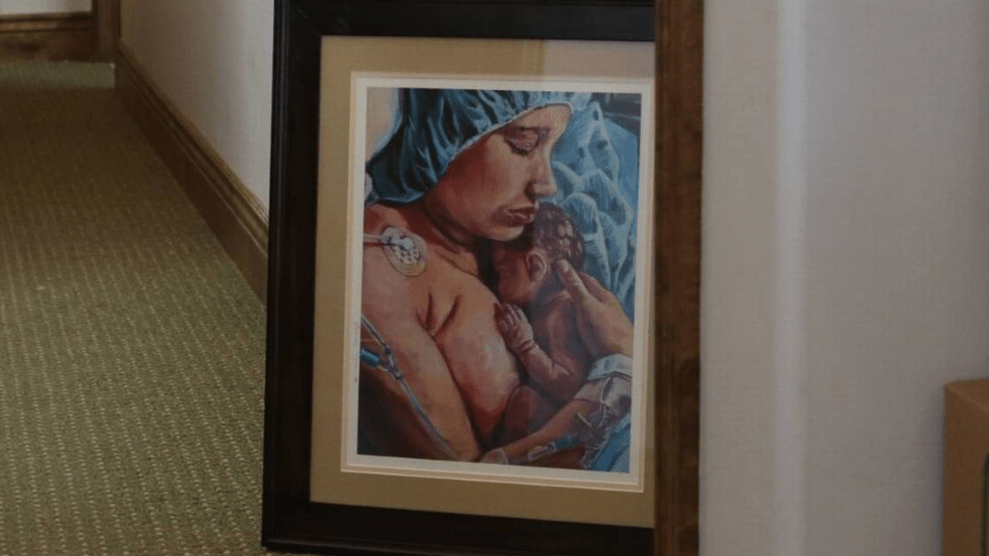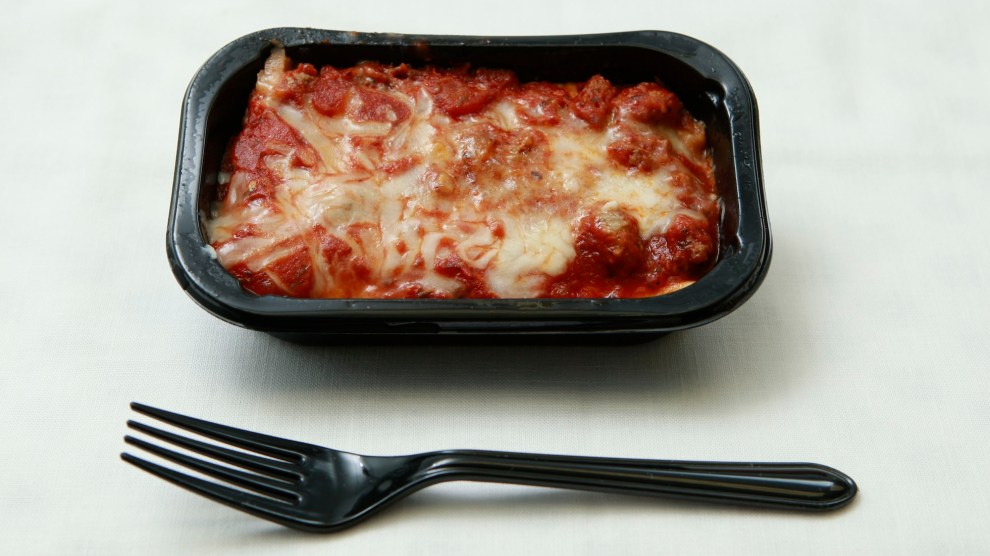
Photo: Getty Images
MoJo 100 | Hard Money 100 | Soft Money 100
Meet the people of Indian Hill 45243.
They’re super-wealthy. They’re ultra-conservative. And, except for the swank residents of Manhattan’s Upper East Side, they have contributed more money to the campaign to reelect President Bush than the people of any other Zip code in the nation.
Unlike the New York elite, residents of Indian Hill, Ohio – the rich core of 45243 – aren’t the talk of the nation or the darlings of paparazzi. But they certainly have tongues wagging in the select, high-stakes world of campaign finance.
One of the Indian Hill 45243s, investor Mercer Reynolds III, is Bush’s chief fundraiser, the grand overseer of his already successful plan to amass a record-breaking $200 million. Another, financier and Cincinnati Reds owner Carl H. Lindner Jr. has donated more money — $2.6 million — to federal candidates, parties and political action committees in the past four years than any other American. A third, uniform company founder Richard T. Farmer, was the nation’s third-largest political donor during that period, having written checks for more than $1.9 million, according to Federal Election Commission records tabulated by the Center for Responsive Politics.
Altogether, the people of 45243 have shelled out $710,940 to the Bush-Cheney campaign, reports the center, a nonpartisan organization that monitors campaign money. That puts Indian Hill and neighboring Madeira slightly below the Upper East Side, which has showered Bush with $992,515 for the November election, but above Dallas, which has given its home-state president $651,970.
It didn’t happen by accident. All 459 residents of Indian Hill and Madeira who have contributed to Bush so far didn’t decide, independently and without consulting one another, to whip out their checkbooks and go GOP. No, the gathering of nearly three-quarters of a million dollars occurred systematically, through the Bush-Cheney campaign’s use of designated “Rangers” and “Pioneers,” who pledge to raise $200,000 and $100,000, respectively. A third group, “Mavericks,” include fundraisers under 40, who raise $50,000 each. Since the new campaign-finance law, pushed by Democrats but largely benefiting Republicans, took effect following the midterm election in 2002, donors can contribute up to $2,000 to a federal candidate for each campaign. That’s twice what they could give two years ago.
The flip side is that they no longer can write enormous checks for six or seven figures in “soft money” to political parties — the preferred method of giving for big-name contributors in both parties over the past decade. Like scores of other prominent Republicans, Lindner, Farmer, and Reynolds used massive soft money donations to work their way into the center of the GOP’s campaign finance machine. Now that those gifts are banned, Lindner, Farmer, and other top-flight Republican givers — including Ameriquest boss Roland Arnell, Univision’s Jerrold Perenchio, and developers Alex Spanos and Joseph Canizaro — needed to find a different approach. And Mercer Reynolds, the money man of Indian Hill, found the ideal way to accommodate them, while also ensuring that the Bush-Cheney campaign would attract more and more $2,000 check-writers.
Rather than reach out to potential donors willy-nilly, rather than waste time and energy casting a broad net, the Bush campaign has perfected a technique used by his predecessors, tapping a relative handful of powerful friends and business acquaintances for assistance “bundling” money. As of late March, 207 people nationwide had signed on to be Rangers and 267 to be Pioneers, according to Bush’s campaign Web site. These bundlers, the Rangers and Pioneers, in turn tap their own friends and associates. Their goal: entice as many as possible to donate the maximum $2,000, often at an event attended by an administration insider. As a result, the list of top Bush-Cheney fundraisers in 2004 reads very much like the list of top Republican donors from four years ago (see The Top 25 Fundraisers).
So important are these first-class fundraisers that Bush, Vice President Cheney and wife Lynne Cheney flew to Greensboro, Ga., at the start of April to fete them during a three-day “Appreciation Weekend.” The exclusive event took place at the Reynolds Plantation, an 8,000-acre, lakeside resort that boasts 81 holes of golf, 50 miles of shoreline and initiation fees of up to $60,000 — all owned by Mercer Reynolds’ family and his multi-million-dollar development company, American Real Estate. Reynolds also hosted a private reception for Bush at his Reynolds Plantation home.
So it was that on Sept. 30, Carl Lindner III, a Ranger, co-president of American Financial Corp. and son of the Reds owner, hosted Bush at his 16-room, 9,250-square-foot Indian Hill home, according to press reports. For $2,000 apiece, attendees munched artichoke truffles and drank from an open bar as they poured $1.7 million into the Bush campaign’s coffers. Reynolds, a former partner with Bush in the Texas Rangers, sponsored a fundraiser featuring First Lady Laura Bush last June that brought in $800,000 for the campaign. The Bush-Cheney campaign declined to comment for this article; Lindner did not return phone calls.
Still, the Upper East Side and Indian Hill are just two stops on the Bush-Cheney fundraising circuit. The residents of eight other wealthy neighborhoods – including Highland Park and University Park in Dallas, Clayton and Ladue outside St. Louis, and Belle Haven in Greenwich, Connecticut – have all sent more than $500,000 to the Bush campaign war chest. Over the past year, Bush has personally attended fundraisers in each of those locales.
The legal practice of bundling individual contributions enhances the influence of wealthy people with fat Rolodexes, says Larry Noble, executive director of the Center for Responsive Politics. “What you have is a system that is very dependent on large fundraisers,” Noble says. “What they want in return is a seat at the table with a new administration. When there’s an energy policy, they want to be invited. When Congress sets a new tax policy, they want to be there.”
The Lindner family, whose holdings include insurance companies and Chiquita Brands International, contributed nearly $1.4 million to federal candidates and committees for the 2002 elections, with 90 percent of it going to Republicans, according to the Center for Responsive Politics.
“They know that being a Ranger, being a Pioneer will help get them in the door, get them access that other people don’t have,” Noble says of big fundraisers. “That’s not necessarily beneficial to the system.”
Sen. John Kerry, the presumptive Democratic nominee, has a similar, but significantly less productive system. The campaign has awarded 184 people with the honorary titles of National Finance Committee vice chairs and co-chairs for raising $100,000 and $50,000, respectively, says senior adviser Michael Meehan. While Bush received $2,000 contributions from 46,246 people by the beginning of March, Kerry took in such large donations from just 5,628 people, the Center for Responsive Politics reported.
Kerry has received only one donation — for $250 – from the 45243 Zip code, according to the center. And on the Upper East Side, the area where both candidates have raised the largest sums, Kerry took in just $417,350, less than half the amount Bush did by March 1.
Indian Hill is the perfect place for Bush to raise massive amounts of money. With 20 square miles of exclusivity on the outskirts of Cincinnati, the village boasts aging country estates that rise from the end of long, private driveways veiled by gates and greenery, of modern, massive mansions and even some middling ranch houses. Most homes sit on five acres of land. There is not one business in the entire community.
According to the Indian Hill Historical Society, “Indians roamed the tree-covered gently rolling hills” before an Army officer bought the area in 1787 for 66 cents an acre. A little more than two centuries later, the 1,753 families of Indian Hill had a median income of $179,356, according to the 2000 U.S. Census. The median house was valued at $738,800. And 95 percent of the 5,907 people there were white.
“Indian Hill has always been heavily Republican,” says Tim Burke, co-chair of Hamilton County Democratic Party, which includes the 45243 Zip code as well as Cincinnati. “The fact that there are personal connections between Bush and his baseball partners puts him in a different league.”
Among Bush’s top fundraisers in Indian Hill are Reynolds and his partner, William DeWitt, who together bought out Bush’s beleaguered oil company in 1984 and later helped make the future president co-owner of the Texas Rangers. DeWitt contributed $363,646 to campaigns and committees the past four years, all of it to Republicans. After Reynolds helped raise money for the 2000 campaign, Bush appointed him ambassador to Switzerland. Other Rangers from Indian Hill 45243 include Farmer, founder and chairman of the Cintas, the nation’s largest uniform rental service, and William O. Brisben, a real estate developer.
U.S. Rep. Rob Portman, a Republican who represents Indian Hill, is an adviser to Bush and powerbroker on Capitol Hill. He did not return phone calls requesting an interview for this story.
“A lot of people are stepping up to the plate,” Portman told the Associated Press outside the Lindner fundraiser in September. “A lot of my friends and neighbors who have never given a penny to a presidential candidate and give little or nothing to the rest of us feel the need to help this president.”











